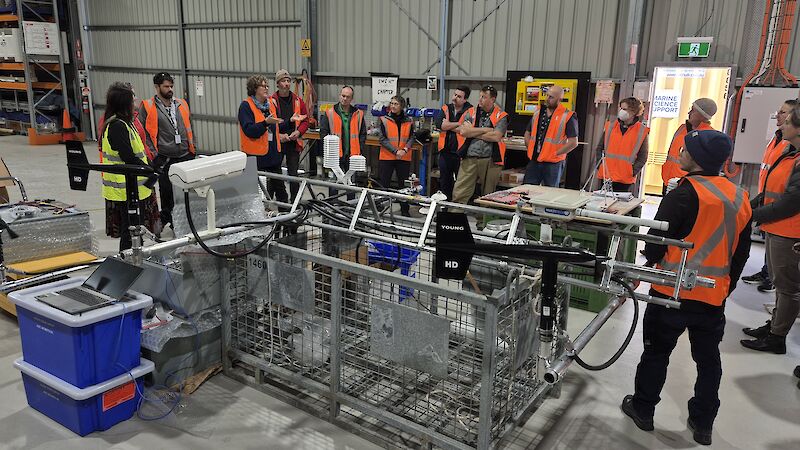One of a planned 20-strong network of Antarctic observing towers, bristling with environmental sensors, is being built to monitor the "old growth forests" of Antarctica - centuries-old moss beds - and other biodiversity, near Casey research station.
The tower will form part of the Antarctic Terrestrial and Nearshore Observing System (ANTOS), aimed at monitoring environmental and biological variability and change, at important biodiversity sites across Antarctica.
The project, led by Professor Dana Bergstrom, formerly of AAD, now University of Wollongong (UOW), involves a number of AAD and UOW* scientists, and is a key component of the AAD's East Antarctic Monitoring Program.

UOW Distinguished Professor Sharon Robinson said the tower, which is currently in prototype form, carries a range of sensors to track the health of mosses, lichens, microbes and soil invertebrates.
Its data logger can then transmit the data in near-real time, allowing live monitoring by the team, other scientists and the broader community.
"This tower will be installed on the Bailey Peninsula, near Casey research station, to monitor the health of moss beds, which we know are several centuries old," Professor Robinson said.
"The tower will allow us to continuously monitor the environment around the moss, so that when events such as the heatwaves that hit in 2008, 2020 and 2022, occur, we'll be collecting the data in real time.
"As a result, we'll be able to track changes in the health of the moss and other biodiversity, and understand how that relates to the changes in environmental conditions."
AAD biologist Dr Jane Wasley established a long-term monitoring project at the site for her PhD in 1999. Subsequent field monitoring and analysis of photos has detected rapid vegetation change over recent decades.
"The microclimate measurements made from the tower will allow investigation of the underlying cause of this change and improve our understanding of local and regional climate impacts on this important site," Dr Wasley said.
UOW spatial biologist and microclimate modeller, Dr Krystal Randall, said the tower carries sensors at one, two and four metres off the ground, in accordance with the World Meteorological Organization's 'CryoNet' site requirements, to ensure comparability between towers and other meteorological observing systems.
"By measuring wind, relative humidity and air temperature at all three heights we're capturing vertical profiles in climate that correspond with other meteorological systems," Dr Randall said.
"This data can be used in models to better understand the climate conditions that terrestrial life experiences in Antarctica.
"We also have non-meteorological sensors that measure photosynthetically active radiation - the wavelengths of light that enable moss to photosynthesise - as well as snow depth, light penetration under snow, soil moisture and net radiation.
"And because Antarctic mosses change colour under stress, we have a camera to capture visual changes in the ecosystem."
Dr Johan Barthelemy, an Artificial Intelligence (AI) and smart sensing expert from NVIDIA and UOW, said the tower was designed to be smart, interoperable and adaptable for future needs, with its advanced computer vision and AI capabilities.
"We're using a specialised, power-efficient edge AI computer, to act as the 'brain' of the system," he said.
"It continuously processes the stream of data and images coming from the sensors, to extract relevant information, minimising the amount of data that needs to be transmitted by satellite back to Australia.
"The tower also has a long-range, low power wireless network (LoRaWAN) module that allows it to communicate wirelessly over long distances. This allows it to relay and collect data from other sensors at other field sites, potentially dozens of kilometres away."
Professor Bergstrom said the team's vision for the network of towers included integration with autonomous drone swarms, currently being designed by Professor Barbara Bollard from UOW, and Ash Doshi from Saidynamics.
"The drones will be able to map biodiversity and collect visual health signatures from more distant sites, on a regular basis and over winter, overcoming the challenges of getting people into the field," Professor Bergstrom said.
The terrestrial towers will also integrate with coastal, lake and marine observing systems, using expertise from the AAD, University of Tasmania and University of New South Wales.
"The towers are the fundamental part of the ANTOS system into which we'll feed exciting technological capabilities as they develop," Professor Bergstrom said.
"Ultimately, the data collected by the ANTOS network will help decision making around how to mitigate climate change impacts on Antarctic biodiversity and provide relevant data to assist management of protected areas."
Tower designer Dugald Mclaren, from UOW, is currently optimising the design, but plans are well advanced for the tower's installation in coming Antarctic seasons.
*UOW scientists involved in this project are part of the Securing Antarctica's Environmental Future (SAEF) special research initiative.






